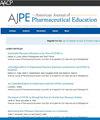A Call to Action for Examining Perimenopause and Menopause Education in Doctor of Pharmacy Curricula
IF 3.8
4区 教育学
Q1 EDUCATION, SCIENTIFIC DISCIPLINES
引用次数: 0
Abstract
Menopause is shifting from a rarely discussed topic to a socially acceptable one that patients and practitioners need to learn about. Instead of being discussed behind closed doors, there is growing recognition that half of the world’s population will experience menopause and its associated phases, including perimenopause. The symptoms associated with hormone fluctuations during perimenopause, premenopause, and menopause significantly impact patients’ quality of life, personal goals, and potentially their contributions to society. While many health care providers are trained to support aging populations, fewer receive specific training on managing the phases of menopause and on the role of hormone therapy, complementary therapies, and lifestyle changes in healthy postmenopausal lives (which can encompass over 40% of a patient’s lifetime). Though patient demand for health care across the lifespan is increasing, little has been added to the curricula of health care professionals, including PharmD programs. The Academy seeks to teach topics that impact underrepresented conditions and special populations; however, some institutions may still under-teach menopause-related issues. This commentary reflects on the need to better understand and improve the time, approaches, and priority given to perimenopause and menopause in PharmD curricula.
对药学博士课程中围绝经期和绝经期教育的探讨。
更年期正从一个很少被谈论的话题转变为一个被社会接受的话题,这也是患者和从业人员需要接受的教育。现在人们越来越认识到,世界上一半的人口将经历更年期及其相关阶段,包括围绝经期,而不是闭门不谈。围绝经期、绝经前和绝经期与激素峰值相关的症状显著影响患者的生活质量、目标和对社会的潜在贡献。虽然许多医疗保健提供者接受过支持老龄化人口的培训,但很少有专门培训支持患者度过更年期阶段,以及激素治疗、补充疗法和/或生活方式改变在健康绝经后生活中的作用(这可能包括患者生命的40%以上)。尽管患者在整个生命周期中对医疗保健的需求不断增加,但医疗保健专业人员的课程中几乎没有增加,包括药学博士(PharmD)教育。学院旨在教授影响代表性不足的条件和特殊人群的主题;然而,一些机构可能仍然缺乏与更年期有关的教育。这篇评论反映了在药学博士课程中需要更好地理解和改进围绝经期和绝经期的时间、方法和优先顺序。
本文章由计算机程序翻译,如有差异,请以英文原文为准。
求助全文
约1分钟内获得全文
求助全文
来源期刊
CiteScore
4.30
自引率
15.20%
发文量
114
期刊介绍:
The Journal accepts unsolicited manuscripts that have not been published and are not under consideration for publication elsewhere. The Journal only considers material related to pharmaceutical education for publication. Authors must prepare manuscripts to conform to the Journal style (Author Instructions). All manuscripts are subject to peer review and approval by the editor prior to acceptance for publication. Reviewers are assigned by the editor with the advice of the editorial board as needed. Manuscripts are submitted and processed online (Submit a Manuscript) using Editorial Manager, an online manuscript tracking system that facilitates communication between the editorial office, editor, associate editors, reviewers, and authors.
After a manuscript is accepted, it is scheduled for publication in an upcoming issue of the Journal. All manuscripts are formatted and copyedited, and returned to the author for review and approval of the changes. Approximately 2 weeks prior to publication, the author receives an electronic proof of the article for final review and approval. Authors are not assessed page charges for publication.

 求助内容:
求助内容: 应助结果提醒方式:
应助结果提醒方式:


